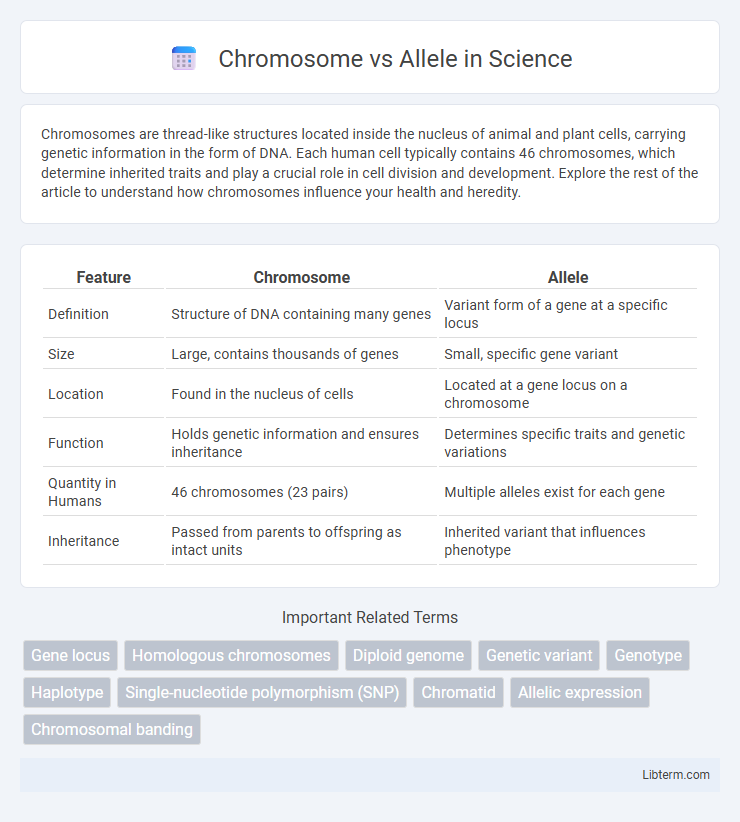Chromosomes are thread-like structures located inside the nucleus of animal and plant cells, carrying genetic information in the form of DNA. Each human cell typically contains 46 chromosomes, which determine inherited traits and play a crucial role in cell division and development. Explore the rest of the article to understand how chromosomes influence your health and heredity.
Table of Comparison
| Feature | Chromosome | Allele |
|---|---|---|
| Definition | Structure of DNA containing many genes | Variant form of a gene at a specific locus |
| Size | Large, contains thousands of genes | Small, specific gene variant |
| Location | Found in the nucleus of cells | Located at a gene locus on a chromosome |
| Function | Holds genetic information and ensures inheritance | Determines specific traits and genetic variations |
| Quantity in Humans | 46 chromosomes (23 pairs) | Multiple alleles exist for each gene |
| Inheritance | Passed from parents to offspring as intact units | Inherited variant that influences phenotype |
Introduction to Chromosomes and Alleles
Chromosomes are long DNA molecules that contain genetic material organized into genes, playing a crucial role in inheritance and cellular function. Alleles are alternative forms of a gene found at the same locus on homologous chromosomes, influencing variations in traits. Understanding the structure and function of chromosomes and the concept of alleles is essential for studying genetics and heredity.
Definition of Chromosome
Chromosomes are long, thread-like structures made of DNA and proteins that carry genetic information within the nucleus of cells, organizing genes in a linear sequence. Each chromosome consists of many genes, which are specific DNA segments that determine inherited traits. Alleles are different versions of a gene located at the same position, or locus, on homologous chromosomes, influencing variations in those traits.
Definition of Allele
An allele is a variant form of a gene located at a specific position on a chromosome, responsible for different traits or characteristics inherited from parents. While chromosomes are long DNA molecules containing many genes, alleles represent the different versions of a single gene that produce variations in inherited traits. Understanding alleles is essential for studying genetic diversity and inheritance patterns within populations.
Structural Differences between Chromosomes and Alleles
Chromosomes are long, thread-like structures composed of DNA and proteins, housing thousands of genes in a linear sequence along their lengths. Alleles are specific variants or versions of a single gene found at the same locus on homologous chromosomes, differing in their nucleotide sequences. Structurally, chromosomes encompass entire genetic material, while alleles represent variations within the gene sequences on those chromosomes.
Chromosomal Function in Genetics
Chromosomes are long DNA molecules containing numerous genes that serve as the fundamental units of heredity, organizing genetic information within the nucleus. Each chromosome ensures accurate DNA replication and distribution during cell division, maintaining genetic continuity across generations. Alleles are specific variants of genes located at corresponding positions on homologous chromosomes, influencing traits by coding different protein versions.
Role of Alleles in Heredity
Alleles are specific variants of a gene located on a chromosome, determining the inherited traits passed from parents to offspring. These different alleles influence phenotypic expressions by dictating the dominant or recessive characteristics within an organism. The interaction of alleles at a genetic locus plays a crucial role in genetic diversity and heredity patterns across generations.
Chromosome Number and Organization
Chromosomes are organized structures of DNA molecules containing hundreds to thousands of genes, with humans typically possessing 46 chromosomes arranged in 23 pairs. Each chromosome carries a specific sequence of genes, while alleles represent different versions of a gene located at the same position, or locus, on a chromosome. The number and organization of chromosomes are crucial for genetic stability, influencing how alleles are inherited and expressed across generations.
Types and Variations of Alleles
Chromosomes are long DNA molecules containing numerous genes that determine an organism's traits, while alleles are different versions of a specific gene located at the same position on homologous chromosomes. Alleles exhibit variations such as dominant, recessive, codominant, and incomplete dominance, influencing gene expression patterns and resulting phenotypic diversity. Types of alleles include wild-type, mutant, multiple alleles, and lethal alleles, each contributing to genetic variability within populations.
Genetic Disorders: Chromosome vs. Allele Mutations
Genetic disorders caused by chromosome mutations often result from structural alterations or an abnormal number of chromosomes, such as in Down syndrome caused by trisomy 21. Allele mutations involve changes in the DNA sequence of a single gene, leading to disorders like cystic fibrosis or sickle cell anemia. Understanding the distinction between chromosome-level abnormalities and allele-specific mutations is crucial for diagnosing and treating genetic diseases effectively.
Summary: Key Differences between Chromosome and Allele
Chromosomes are long DNA molecules that contain many genes, serving as the structural units of genetic material in cells, while alleles are different versions of a specific gene located at a particular locus on a chromosome. Each chromosome carries multiple genes, and alleles represent the variations within those genes that contribute to genetic diversity and traits. Understanding these key differences is crucial for genetics, as chromosomes organize genetic information broadly, whereas alleles determine the specific expression of traits.
Chromosome Infographic

 libterm.com
libterm.com